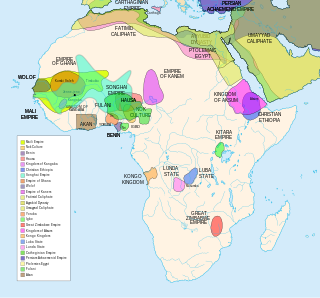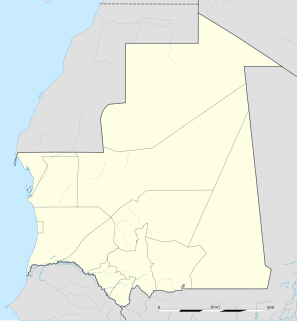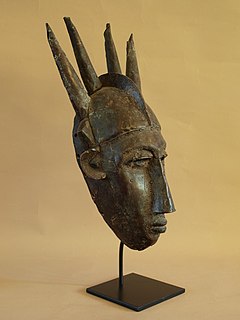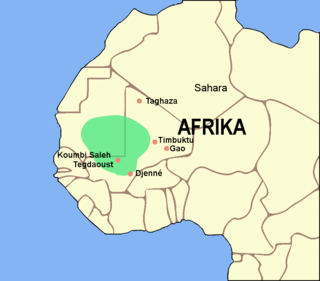
The history of Africa begins with the emergence of hominids, archaic humans and—at least 200,000 years ago—anatomically modern humans, in East Africa, and continues unbroken into the present as a patchwork of diverse and politically developing nation states. In the Kingdom of Kush and in Ancient Egypt, the Sahel, the Maghreb and the Horn of Africa.

North Africa is a region encompassing the northern portion of the African continent. There is no singularly accepted scope for the region, and it is sometimes defined as stretching from the Atlantic shores of Morocco in the west, to Egypt's Suez Canal and the Red Sea in the east. Others have limited it to the North West African countries of Algeria, Morocco, and Tunisia, a region that was known by the French during colonial times as "Afrique du Nord" and is known by all Arabs as the Maghreb. The most commonly accepted definition includes Algeria, Sudan, Morocco, Tunisia, Libya and Egypt, the 6 countries that shape the top North of the African continent. Meanwhile, "North Africa", particularly when used in the term North Africa and the Middle East, often refers only to the countries of the Maghreb and Libya. Egypt, being also part of the Middle East, is often considered separately, due to being both North African and Middle Eastern at the same time.

Central Africa is the core region of the African continent which includes Burundi, the Central African Republic, Chad, the Democratic Republic of the Congo, and Rwanda. Middle Africa is an analogous term that includes Angola, Cameroon, the Central African Republic, Chad, the Democratic Republic of the Congo, Equatorial Guinea, Gabon, the Republic of the Congo, and São Tomé and Príncipe. All of the states in the UN subregion of Middle Africa, plus those otherwise commonly reckoned in Central Africa, constitute the Economic Community of Central African States (ECCAS). Since its independence in 2011, South Sudan has also been commonly included in the region.

Guinea is a traditional name for the region of the African coast of West Africa which lies along the Gulf of Guinea. It is a naturally moist tropical forest or savanna that stretches along the coast and borders the Sahel belt in the north.
The Dyula are a Mande ethnic group inhabiting several West African countries, including the Mali, Cote d'Ivoire, Ghana,and Burkina Faso.

Koumbi Saleh, sometimes Kumbi Saleh is the site of a ruined medieval town in south east Mauritania that may have been the capital of the Ghana Empire.
Trans-Saharan trade requires travel across the Sahara to reach sub-Saharan Africa from the North African coast, Europe, to the Levant. While existing from prehistoric times, the peak of trade extended from the 8th century until the early 17th century.

Mandé is a family of ethnic groups in Western Africa who speak any of the many related Mande languages of the region. Various Mandé groups are found in Benin, Burkina Faso, Côte d'Ivoire, The Gambia, Ghana, Guinea, Guinea-Bissau, Liberia, Mali, Mauritania, Niger, Nigeria, Senegal and Sierra Leone. The Mandé languages are divided into two primary groups: East Mandé and West Mandé.

Like other aspects of the culture of Africa, the architecture of Africa is exceptionally diverse. Throughout the history of Africa, Africans have develolped their own local architectural traditions. In some cases, broader regional styles can be identified, such as the Sudano-Sahelian architecture of West Africa. A common theme in traditional African architecture is the use of fractal scaling: small parts of the structure tend to look similar to larger parts, such as a circular village made of circular houses.

The history of West Africa began with the first human settlements around 4,000 BCE. It has been commonly divided into its prehistory, the Iron Age in Africa, the major polities flourishing, the colonial period, and finally the post-independence era, in which the current nations were formed. West Africa is west of an imagined north-south axis lying close to 10° east longitude, bordered by the Atlantic Ocean and Sahara Desert.
The Wangara are Soninke subgroups and later ethno-Linguistically assimilated merchant class that specialized in both Trans Saharan and Secret Trade of Gold Dust. Their diaspora operated all throughout West Africa Sahel-Sudan. Fostering regionally organized trade networks and Architecture projects. But based in the many Sahelian and Niger-Volta-Sene-Gambia river city-states. Particularly Dia, Timbuktu, Agadez, Kano, Gao, Koumbi Saleh, Guidimaka, Salaga, Kong, Bussa, Bissa, Oyo-Ie, Kankan, Jallon, Djenné as well as Bambouk, Bure, Lobi and Akan goldfields. They also were practicing Muslims with a clerical social class (Karamogo), Timbuktu Alumni political advisors, Sufi Mystic healers and individual leaders (Marabout). Living by a philosophy of merchantile pacifism called the Suwarian Tradition. Teaching peaceful coexistence with non-Muslims, reserving Jihad for self-defence only and even serving as Soothsayers or a "priesthood" of literate messengers for non-Muslim Chiefdoms/Kingdoms. This gave them a degree of control and immense wealth in lands where they were the minority. Creating contacts with almost all West African religious denominations. A group of Mande traders, loosely associated with the Kingdoms of the Sahel region and other West African Empires. Such as Ghana, Mali, Songhai, Yorubaland, Akan, Kong, Borgu, Dendi, Macina, Hausa Kingdoms & the Pashalik of Timbuktu. Wangara also describes any land south of Timbuktu and Agadez. The Bilad-Al-Sudan or Bilad-Al-Tibr, "Land of Black" or "Gold."
Akwamu was a state set up by Akan people that flourished in the 17th and 18th centuries. The name was also applied to its people. Originally emigrating from Bono state, the Akan founders settled in Twifo-Heman. The Akwamu led an expansionist empire in the 17th and 18th centuries. At the peak of their empire, the Akan created an influential culture that has contributed to at least three countries in West Africa.

Pre-imperial Mali refers to the period of history before the establishment of the Mali Empire, a pre-colonial African empire located mostly in present-day Mali, in c. 1235.

African empires is an umbrella term used in African studies to refer to a number of pre-colonial African kingdoms in Africa with multinational structures incorporating various populations and polities into a single entity, usually through conquest.
The Intermediate Region is an established geopolitical model set forth in the 1970s by the Greek historian Dimitri Kitsikis, professor at the University of Ottawa in Canada. According to this model, the Eurasian continent is composed of three regions; in addition to Western Europe and the Far East, a third region called the "Intermediate Region" found between the two constitutes a distinct civilization. It roughly covers Eastern Europe and the Middle East and North Africa.

Precolonial Mauritania, lying next to the Atlantic coast at the western edge of the Sahara Desert, received and assimilated into its complex society many waves of Saharan migrants and conquerors.

The Ghana Empire, properly known as Wagadou, was a West African empire located in the area of present-day southeastern Mauritania and western Mali. Complex societies based on trans-Saharan trade with salt and gold. had existed in the region since ancient times, but the introduction of the camel to the western Sahara in the 3rd century CE, opened the way to great changes in the area that became the Ghana Empire. By the time of the Muslim conquest of North Africa in the 7th century the camel had changed the ancient, more irregular trade routes into a trade network running from Morocco to the Niger river. The Ghana Empire grew rich from this increased trans-Saharan trade in gold and salt, allowing for larger urban centres to develop. The traffic furthermore encouraged territorial expansion to gain control over the different trade routes.
Sheikh Al-Hajj Salim Suwari was a 13th-century West African Soninke karamogo who focused on the responsibilities of Muslims minorities residing in a non-Muslim society. He formulated an important theological rationale for peaceful coexistence with the non-Muslim ruling classes called the Suwarian tradition, which survives to this day despite the pressures of modernism.

The barbarian kingdoms were Germanic, Hunnic and other kingdoms established all over Europe and North Africa during Late Antiquity, after the fall of the Western Roman Empire. The term "barbarian" has been commonly used by historians even though the term was not used by the peoples in question and carries considerable value judgement. Other terms used include "Germanic kingdoms", "Romano-Germanic kingdoms", and "post-Roman kingdoms".


















